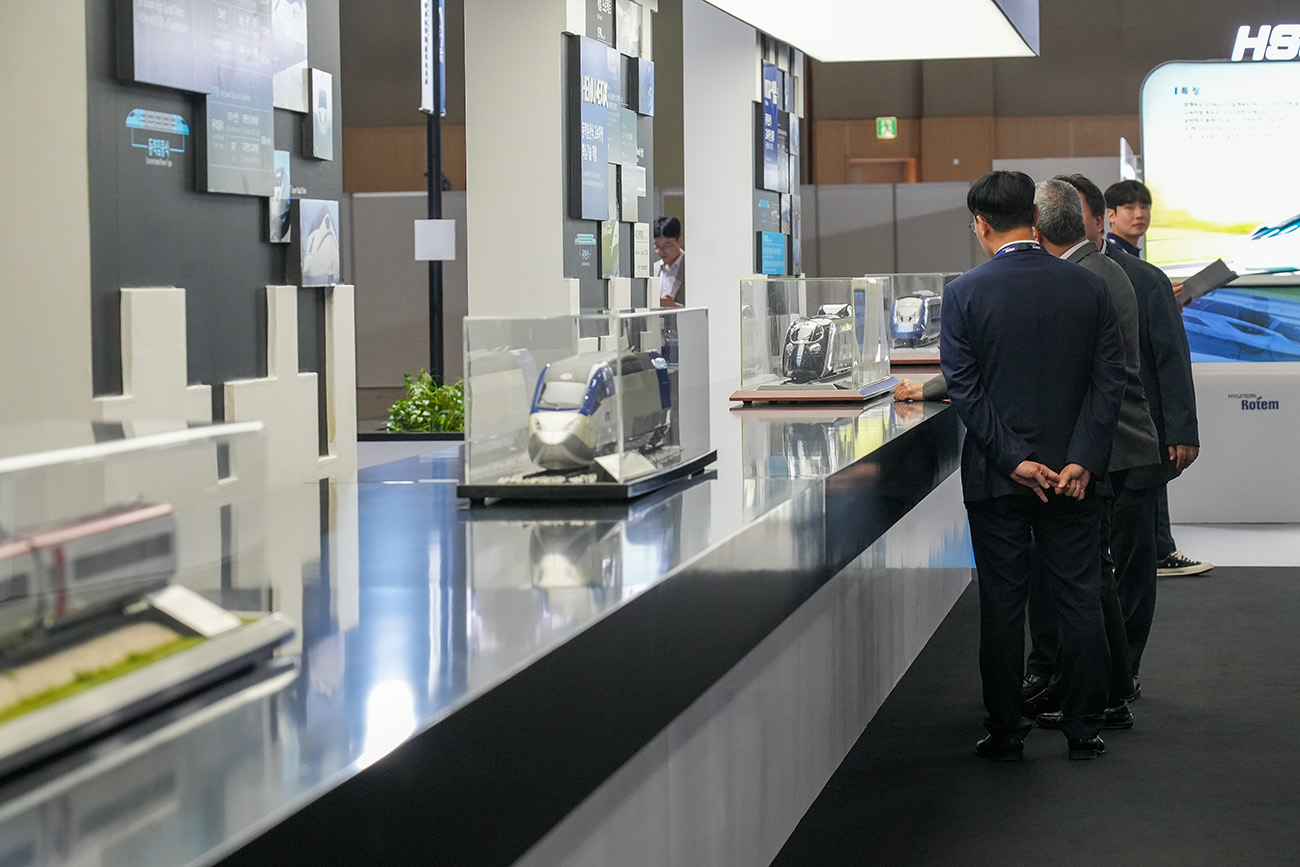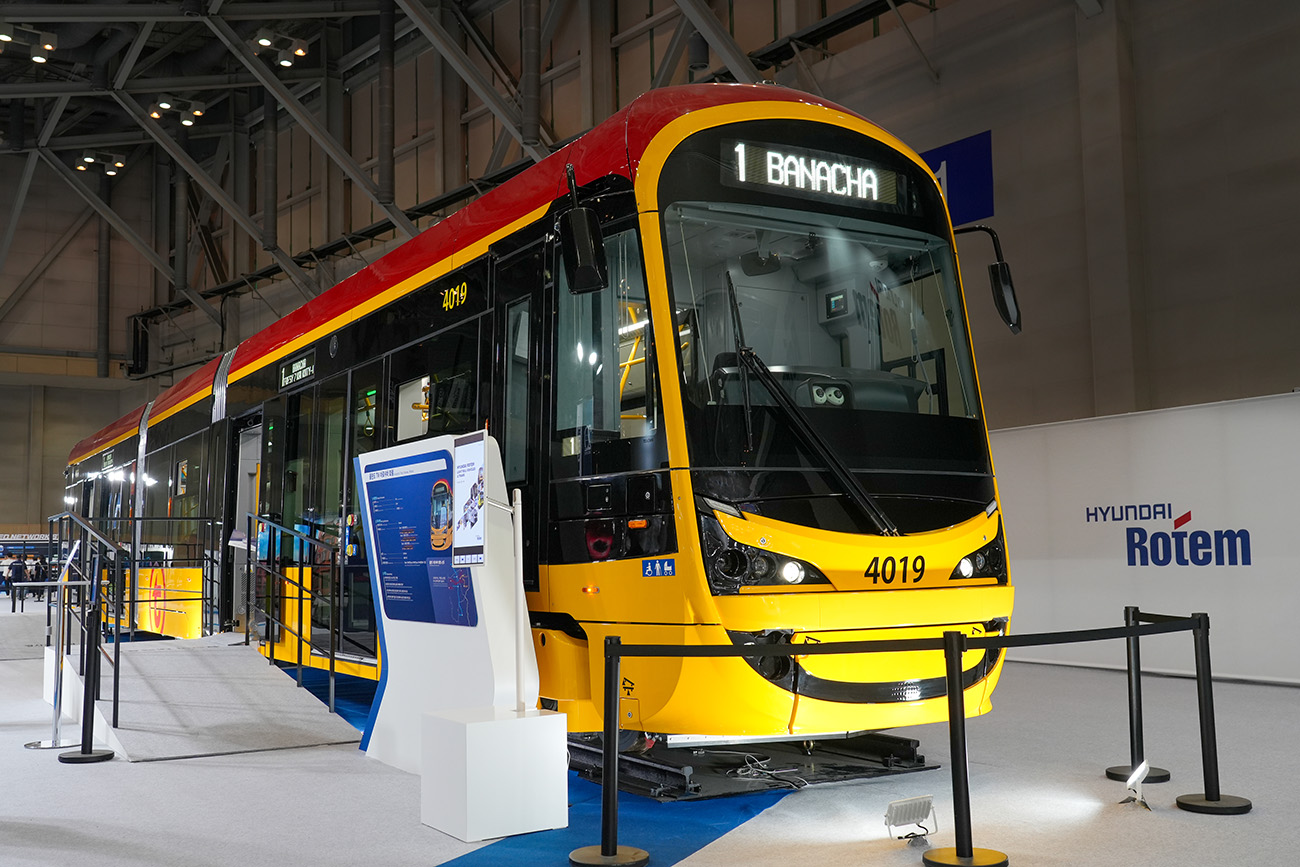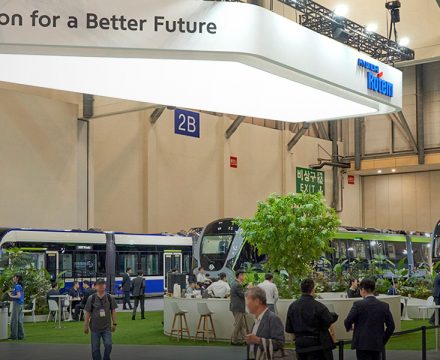‘RailLog Korea 2023’ was held at Busan BEXCO where Hyundai Rotem unveiled its next-generation railway technology and products. This fair is celebrating its 11th anniversary and it is the largest railway exhibition in Korea, focusing on introducing domestic and foreign railway industry technology and products.
Hyundai Rotem had the largest exhibit among the companies participating in this exhibition. The company has put on a rich exhibit featuring the development history of its flagship models of high-speed trains, eco-friendly hydrogen fuel cell trains, and other trains exported to various countries overseas. Also, the exhibit showcased various railway technologies, including the railway signal system. The following describes the on-site experience at RailLog Korea 2023, where Hyundai Rotem has put its past and present on display as well as its next-generation trains and technologies for the future as a leader of the railway industry in Korea.
Hyundai Rotem’s History of High-speed Rail Development Throughout 20-Years History of High-speed Rail

The ‘HISTORY FLOW Zone’ begins as you enter the exhibition booth of Hyundai Rotem. This zone consists of the display of the actual distributed traction type high-speed train ‘EMU-320’ and the Korean High-speed Railway History Exhibition Hall, and you can experience the exhibition that showcases the 20-years history of high-speed railways since the opening of the KTX lines back in 2004.

The Korean High-speed Railway History Exhibition Hall begins with the Korean high-speed train ‘G7’, which served as the foundation for securing the concentrated traction type high-speed vehicle technology, which was the fourth of its kind at the time in the world in 1996, and leads up to the ‘KTX-Sancheon’, the first commercialized high-speed train in Korea back in 2008.

Also, there was the distributed traction model ‘HEME-430X’, which began development in 2007 and served as the foundation for the next-generation high-speed train and Korea’s first commercialized distributed traction model ‘EMU-260 (KTX-Eum)’, which has been operating in the Gangneung Line, Central Line, and Jungbu Inland Line since January last year.

On the opposite side of the train model exhibition space, there were materials and train line maps depicting the ideologies at the time when the high-speed railway first opened. Especially for the Gyeongbu High Speed Railway, which connects major cities between Seoul and Busan, you can see that various things including the economy and culture of Korea have changed as it has transformed into a country where people can truly travel across the country within half the day.

As it is a transportation being used by many people today, the Korean High-speed Rail History Exhibition Hall offered scale models of trains that were part of the history of high-speed railways in Korea as well as other various information related to the history of high-speed railways in Korea, which was received positively by the visitors due to the organized flow of information.

You can see the distributed traction type high-speed train ‘EMU-320’ on display next to the High-speed Rail History Exhibition Hall. This model has increased its maximum speed up to 320km/h in just three years since the release of EMU-260, and is currently in the test driving phase with the goal of being operational in the Honam High Speed Railway next year. This model can reduce the travel time between Seoul and Busan by approximately 25 minutes compared to the currently operating KTX-Eum.

‘EMU-320’ carries significance in the sense that it is a distributed traction type train. Unlike concentrated traction type where tractions are attached at both ends of the train, the EMU-320 comes with power dispersed across all cars including passenger cars, thus offering higher energy efficiency and power performance in terms of acceleration and deceleration. EMU-320 will bring a comfortable riding experience to passengers with improved speed and pleasant interior space and the train will be operated by KORAIL and SRT.

Next to the HISTORY FLOW Zone, there was the ‘H2 TECH FLOW Zone’, which displayed high-speed railways as well as the ‘GTX-A’ train for the rapid metropolitan railway, which is anticipated to revolutionize the transportation system in Korea along with the high-speed railway. The GTX railway has newly constructed linear lines underground and offers a scheduled speed that doubles the existing subways (maximum speed 180km/h) so it is anticipated to significantly reduce the transportation inconvenience in the outer capital district. Once the GTX-A line connecting Unjeong and Dongtan opens, Seoul and other cities in the capital district will be connected with a travel time of around 30 minutes, and it is projected that there will be a reduction of annual carbon dioxide emissions by approximately 440,000 tons when the road traffic is dispersed and reduced through this effort.

The interior space was designed to be more spacious and bring a more comfortable atmosphere as the seat width was increased from 450mm to 480mm while the seat separation structure was applied between the seats to improve convenience and independence. There are also large 29-inch displays installed between the top of the entrance doors and passenger seats to provide various information. Also, the train was fitted with carpets certified with eco-friendly certification, which is the first to do so in Korea, as it created a cozy yet luxurious interior atmosphere. The train was also equipped with the ‘noise-reducing single-type plug-in door’, which is around 1.6m in width and it was the first time such a door was applied in trains in Korea. It also featured windows used in high-speed vehicles for reducing travel impact and indoor noise reduction to create an optimal and silent indoor atmosphere.
Hyundai Rotem’s Railcars Exported Overseas Gathered in One Place

You can also have the rare experience of seeing various train models of Hyundai Rotem exported overseas at this event. Since first exporting its Tram to Izmir, Turkey in 2017 in the European tram market, Hyundai Rotem has been exporting trams to Europe where trams originated as the company continued to export other models to Warsaw, Poland in 2019. You can experience an exotic feel as you experience trams that can only be found outside of Korea as you observe the trams exported to Warsaw on display.

Trams are the most common public transportation you can see across Europe. The ‘Poland TW Warsaw Tram’ features an eye-catching yellow and the longest carbody among all trams in Warsaw at 33m and offers a maximum speed of 70km/h. It can run both with or without catenary depending on the situation and is equipped with ultra capacitors that store regenerative braking energy, reducing energy consumption by 30% compared to other trams operated in the region.

You can also see the ‘TRA EMU’, which is currently running across the lands of Taiwan after its sales agreement for 520 vehicle units back in 2018. Taiwan’s commuter EMU reduced its weight by approximately 10% compared to the previous model to reduce electricity consumption and offers a maximum speed of up to 130km/h. Its unique design creates an illusion as if the train is welcoming the passengers with a smile, and this design was inspired by the phrase ‘A smiling welcome’ and created via collaboration between Hyundai Rotem and ‘MBD Technologies’, the design team for TGV of France. This model is beloved by local passengers due to its friendly image.

Also, there was the ‘Australia NIF Multi-level EMU’ on display, a model exported back in 2016, which runs across the western suburb railway in the state of New South Wales, Australia. This model is an eco-friendly low carbon train that can run at the maximum speed of 160km/h. This model is named ‘Mariyung’, which is a word for EMU in the ‘Dharuk’ language, chosen out of respect for the aboriginal culture in the state of New South Wales, Australia. and it holds deep significance as the railway passes through the regions home to a significant number of aboriginal people.

The Australia NIF EMU features a two-floor structure for a more efficient way to board even more passengers as it travels across the railways running across the wide continent of Australia. You can see passengers boarding the train being fascinated by the uncanny and unique internal structure where passengers can go up and down between the floors using the stairs and closely examining the internal structure maximizing space efficiency within the limited space within the train.

RailLog Korea 2023 offered a peak at Hyundai Rotem’s footprints in the development of the high-speed rail industry as the company adapted to the trends of the global railway industry and its core technology of the semi-high speed railcar GTX-A. It was a special exhibition where you could observe the 20-year history of domestic high-speed rail while also witnessing the performance of Hyundai Rotem as it successfully exported its products overseas based on the technology that the company has accumulated across the entire historical timeline of high-speed rails in Korea.



